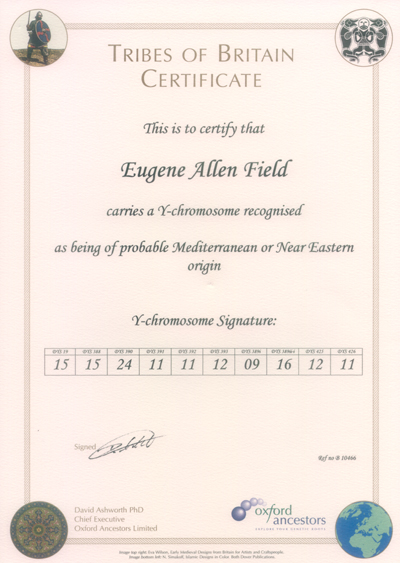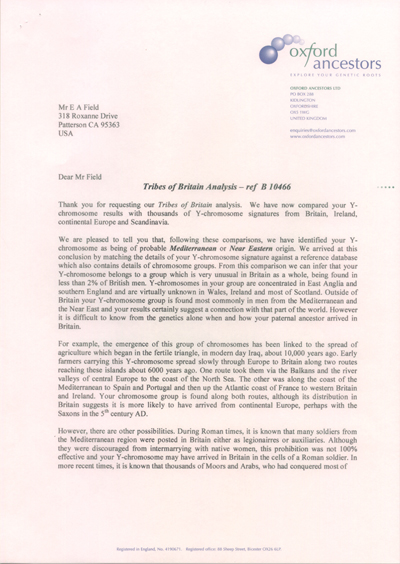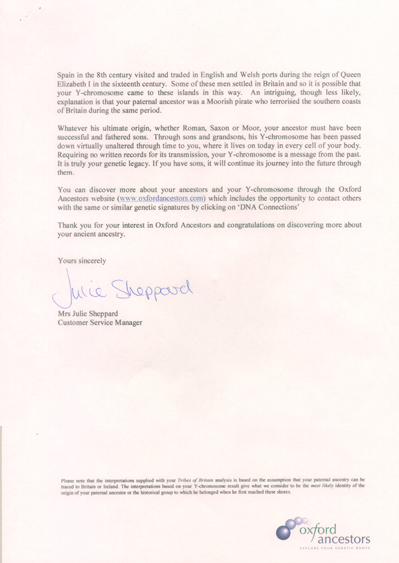The Y Chromosome and the Field Family

|
Celtic Tribes of Britain |
|
|
At the time of the Roman conquest of Britain the islands were inhabited by people of Celtic origin. The Romans wrote about these people and based upon this and other sources of information the Celtic Tribes have been named and described. If you are a male and your direct male paternal ancestors are from Britain it is quite likely you descend from one of these tribes. One of the services of Oxford Ancestors is to compare your Y chromosome DNA to their data base and determine the tribe from which you have most likely descended. |
|
|
On the BBC website are listed 27 Tribes with a map of their locations. There are other web sites that discuss these tribes and give detailed information about them. |
|
|
Upon having my Y chromosome DNA analyzed I was aligned with the Re Clan (Y Chromosome page) I decided it would be interesting to see from which of the Tribes of Britain I descend. I received my certificate and a very interesting letter from Oxford Ancestors with the information that I was not a descendant of any of the Celtic Tribes of Britain! I was not really surprised at this information. My Y chromosome DNA places me in the Clan of Re and this clan originated in the Middle East, most likely in Iraq about 10,000 years ago. Click here to read the letter I received from Oxford Ancestors telling me where my ancient male ancestors might have come from. It also speculates on how my first male ancestor might have arrived in England. |
|
|
Based upon the information that Oxford Ancestors has collected only 2% of British men have the Re Clan Y chromosome. These men are not descendants of any of the Celtic Tribes of Britain through their fathers. Men with Re Clan Y chromosomes live mostly in East Anglia and Southern England with almost none living in Wales, Ireland or Scotland. |
|
|
This does not mean that my ancesters absolutely were not a member of one of the Celtic Tribes. If the first ancestor with my Y chromosome immigrated to England 6000 years ago at the end of the northern migration of the Re Clan then they would have blended into the British population of the time and became part, although a very small part, of the general population. However, since the Re Clan Y chromosome type makes up only 2% of the present day British population my guess is that the ancestor with the Re Y chromosome arrived much later and was either a single man, a few brothers or a man with very few sons. The family continued but did not become very numerous. It is possible for one man to be the ancestor of a large number of people. Keen Field and Anna Lewis were the first of our Field family in southern Indiana in the very late 1700's. Today we know of approximately 1200 descendants and we have many lines that we have not been able to follow. |
|
|
People with the Re Y chromosome are connected with the advent of agriculture in the fertile crescent region between the Tigris and the Euphrates Rivers in Iraq. The descendants of this clan migrated out of the Middle East and into Europe along two routes. The northern route was through the Balkans and along the river valleys of central Europe to the coast of the North Sea. The other migration route was through Turkey, Greece, Italy and eventually a small number reached the British Isles. |
|
|
The most intriguing fact is that the Y chromosome I have is only present in 2% of the British male population and is fairly restricted in distribution in England. This leads to many unanswered questions as to the origin of the ancestors of this branch of the Field Family. |
|
|
In the letter I received from Oxford ancestors there were several suggestions as to the origin of my ancestors who at one time settled in England. One suggestion is that they were Saxons arriving in the 5th century AD. Another possibility is that Roman soldiers (100BC to AD450) or the Moors (Arabs) who conquered Spain and Portugal during the 8th century AD. left sons with the Re Y Chromosome. These people traded with England during the time of Queen Elizabeth I in the 16th century. Some of these people settled in England as well. |
|
|
Many people interested in the genealogy of the Field family rely heavily on the information in Field Genealogy by published Frederick Clifton Pierce in 1901. In the sections, “Early History of the Field Family” and “Origin of the Field Name” most of the information is pure conjecture. The first person with the name Field to immigrate to England is reported to be Sir Hubertus de la Feld of the Alsace Lorraine area of France. According to some sources, whose reliability is suspect, Sir Hubertus accompanied William the Conqueror to England in 1066 and settled in Lancaster County. Even Pierce states that much of the information is “imperfect” to use his exact word. (Pierce 9) |
|
|
The actual origin of the Field surname and the line of direct ancestors of the Fields in America is lost in history and will most likely remain a mystery forever. |
|
|
Another mystery that may be more easily solved is the origin of the Virginia Field family line in America. Again, there is much speculation concerning the earliest immigrant whose descendants are the members of this family. As we state in our introduction to this web site Abraham Field, (abt. 1636 - 1674) of Westmoreland County, Virginia, is the documented ancestor of this specific branch of the Field Family. (See Documentation to Establish Descent of Eugene Allen Field from Keen Field of Gibson County, Indiana) It is often stated that Abraham's father was Henry Field born in 1611 in England. There is documentation that a Henry Field along with a relative John Dickenson, sailed on the ship Expectation. The ship cleared from London and landed in Virginia, November 20, 1635. (Pierce 1101) According to Pierce, Henry, his brothers and father took a prominent part in religious controversies in London, England. As a result, he was obliged to flee to America to avoid persecution. Pierce also states that he died in Jamestown Virginia.Also according to Pierce, Henry had three brothers, Richard, Darby and Robert. Darby is reported to have immigrated from Boston England to Boston, Massachusetts. in 1636, then to Exeter, New Hampshire, and finally to Dover, New Hampshire. (Pierce 949). Darby is the ancestor of many of the Field families of New England. |
|
|
One way to begin to prove that Henry and Darby were brothers and that Henry was the father of Abraham of Westmoreland County, Virginia, would be for descendants of Darby and descendants of Abraham from his sons and grandsons have their Y chromosome analyzed to see if the mutation sequence is the same. |
|
|
Many families are encouraging males within the family to have a DNA analysis to determine if they descend from a common ancestor. If any male descendant of Abraham Field of Westmoreland County, Virginia, is interested and willing to have his Y chromosome DNA tested I would be extremely interested in the results. The results of my test are available from my web page Oxford Ancestors Y Clan World Chart |
|

|

|
|
Click on images for larger view |
|

|
Links to Relationships: DNA and Genealogy |
|||||||||||||
|
|
|||||||||||||
|
|
|||||||||||||
|
|
|||||||||||||
|
Oxford Ancestors Seven Daughters of Eve Chart
|
